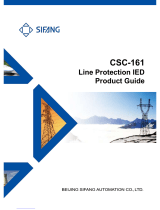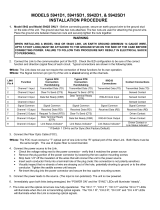
14.2.3 Setting guidelines............................................................................................................................ 193
14.3 Generic communication function for Double Point indication DPGAPC................................... 193
14.3.1 Identification.....................................................................................................................................193
14.3.2 Application.........................................................................................................................................193
14.3.3 Setting guidelines............................................................................................................................ 194
14.4 Single point generic control 8 signals SPC8GAPC......................................................................... 194
14.4.1 Identification.....................................................................................................................................194
14.4.2 Application........................................................................................................................................ 194
14.4.3 Setting guidelines............................................................................................................................ 194
14.5 AutomationBits, command function for DNP3.0 AUTOBITS....................................................... 195
14.5.1 Identification.....................................................................................................................................195
14.5.2 Application.........................................................................................................................................195
14.5.3 Setting guidelines............................................................................................................................ 195
14.6 Single command, 16 signals SINGLECMD........................................................................................ 195
14.6.1 Identification.....................................................................................................................................195
14.6.2 Application........................................................................................................................................ 196
14.6.3 Setting guidelines............................................................................................................................ 197
Section 15 Logic...................................................................................................................... 199
15.1 Tripping logic SMPPTRC (94)............................................................................................................. 199
15.1.1 Application........................................................................................................................................ 199
15.1.1.1 Three-pole tripping .....................................................................................................................200
15.1.1.2 Single- and/or three-pole tripping........................................................................................... 200
15.1.1.3 Single-, two- or three-pole tripping.......................................................................................... 202
15.1.1.4 Lock-out..........................................................................................................................................202
15.1.1.5 Blocking of the function block................................................................................................... 202
15.1.2 Setting guidelines............................................................................................................................202
15.2 Trip matrix logic TMAGAPC................................................................................................................ 203
15.2.1 Identification.................................................................................................................................... 203
15.3 Logic for group alarm ALMCALH.......................................................................................................203
15.3.1 Identification.................................................................................................................................... 203
15.3.2 Application........................................................................................................................................ 203
15.3.3 Setting guidelines............................................................................................................................203
15.4 Logic for group alarm WRNCALH......................................................................................................204
15.4.1 Logic for group warning WRNCALH.............................................................................................204
15.4.1.1 Identification.................................................................................................................................204
15.4.1.2 Application.....................................................................................................................................204
15.4.1.3 Setting guidelines........................................................................................................................ 204
15.5 Logic for group indication INDCALH................................................................................................204
15.5.1 Logic for group indication INDCALH........................................................................................... 204
15.5.1.1 Identification.................................................................................................................................204
15.5.1.2 Application.....................................................................................................................................204
15.5.1.3 Setting guidelines........................................................................................................................ 204
Table of contents
6
Application manual





















